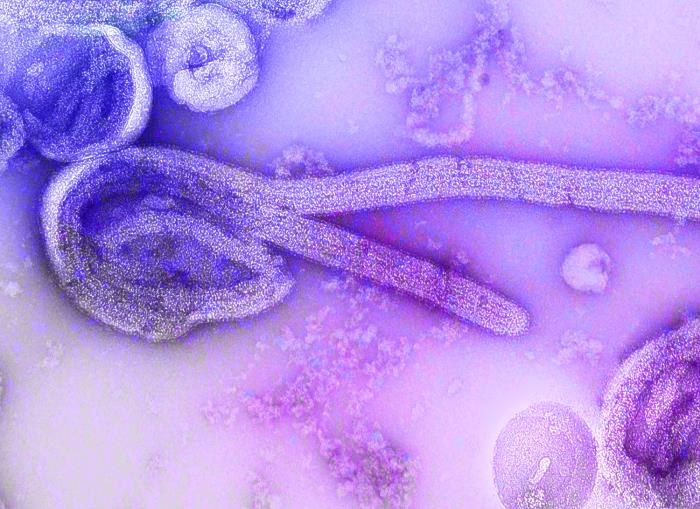Promising Marburg vaccine yet to be tested on humans due to lack of funding
Oxford University’s Professor Teresa Lambe, the designer of the vaccine, fears Marburg disease is ‘now being seen in places where it’s never been seen before’

Your support helps us to tell the story
This election is still a dead heat, according to most polls. In a fight with such wafer-thin margins, we need reporters on the ground talking to the people Trump and Harris are courting. Your support allows us to keep sending journalists to the story.
The Independent is trusted by 27 million Americans from across the entire political spectrum every month. Unlike many other quality news outlets, we choose not to lock you out of our reporting and analysis with paywalls. But quality journalism must still be paid for.
Help us keep bring these critical stories to light. Your support makes all the difference.
A promising Marburg vaccine developed by the same Oxford scientists behind the Covid-19 jab has yet to be tested in humans due to a lack of funding.
Professor Teresa Lambe, a vaccinologist at the University of Oxford, said Marburg virus is “now being seen in places where it’s never been seen before,” citing West Africa and, specifically, Ghana, which declared its first-ever outbreak earlier this month.
There are no vaccines against the virus, which can kill up to 88 per cent of people it infects, and nor are there any treatments available.
Prof Lambe and her team have developed a vaccine which appears to generate a “good immune response” in animals, but they are unable to test the jab in human trials because of limited funding.
“We’ve been able to get money to progress this to a stage where we can make a product that is ready to go in people’s arms,” she told The Independent. “But we haven’t yet got any money to get the vaccine into clinical trial.
“That’s certainly something that we will be looking to do as soon as we’ve got the vaccine ready. This speaks to the whole field where we’re able to make these vaccines, but there isn’t funding that will allow us to test these vaccines or get them across the finish line.”
Like the Oxford/AstraZeneca jab, Prof Lambe’s vaccine uses an adenoviral vector platform to deliver genetic instructions to the immune system and generate a response against the Marburg virus, which belongs to the same viral family as Ebola, known as filoviruses.
A licensed Ebola vaccine already uses the same platform technology, raising hope that Prof Lambe’s own jab will also prove effective against Marburg given the similarities between the two pathogens.
“Our vaccine can induce an immune response, so it induces antibodies and T cells, but we’re not sure to be honest if the level that we’re inducing will be high enough to protect against Marburg,” she said.
“But there is data in the field for the related Ebola virus that the platform technology that we’re using does induce antibodies and T cells to a similar level. However, we really need to get it into people’s arms to see if the responses are good enough or strong enough.”
Last week, Ghana confirmed two cases of the Marburg virus, in what was its first outbreak of the infection.
The two people tested positive for the virus, before later dying, but the results were later verified by a laboratory in Senegal, according to the World Health Organisation (WHO).
A total of 98 people have been placed into quarantine as suspected contact cases, Ghanaian health officials said.
It is only the second outbreak of Marburg in west Africa. The first ever case of the virus in the region was detected last year in Guinea, with no further cases identified.
“So the first case of it being detected in West Africa was in 2021. And now in 2022, we’re having reports in Ghana. So it’s obviously spreading,” Dr Lambe said. “But I have to say contact tracing can be very effective in stopping onward transmission, if we catch it early enough.
“Having said that, I know that there are 90 people being followed up for contact tracing for the current two cases and fatalities that happened. It scares me if this were to spread, if it were to become more transmissible, because of the the associated high fatality rate.”
Dr Lambe said governments and pharmaceuticals were running a risk by not investing in vaccines against pandemic-potential pathogens that could one day fuel the next global outbreak.
She said the speed at which the world had developed a Covid-19 vaccine had created “a bit of complacency” and given the impression that the world will be able to speedily produce a new jab for the next pandemic.
“People have seen that medical researchers, clinicians, scientists could do this in less than a year and I suspect that they are banking that it can be done again for the next pandemic. There’s a bit of complacency around this.
“I think that’s a bit foolhardy. We were lucky with this pandemic. Why would we not take what we’ve learned and use it to be in a better situation for the future?”
There have been a dozen major Marburg outbreaks since 1967, mostly in southern and eastern Africa. Fatality rates have varied from 24 per cent to 88 per cent in past outbreaks, depending on the virus strain and case management, according to the WHO.
The virus killed more than 200 people in Angola in 2005, in the deadliest outbreak on record.
It is transmitted to people from fruit bats and spreads among humans through direct contact with the bodily fluids of infected people, surfaces and materials.
Subscribe to Independent Premium to bookmark this article
Want to bookmark your favourite articles and stories to read or reference later? Start your Independent Premium subscription today.
Join our commenting forum
Join thought-provoking conversations, follow other Independent readers and see their replies
Comments